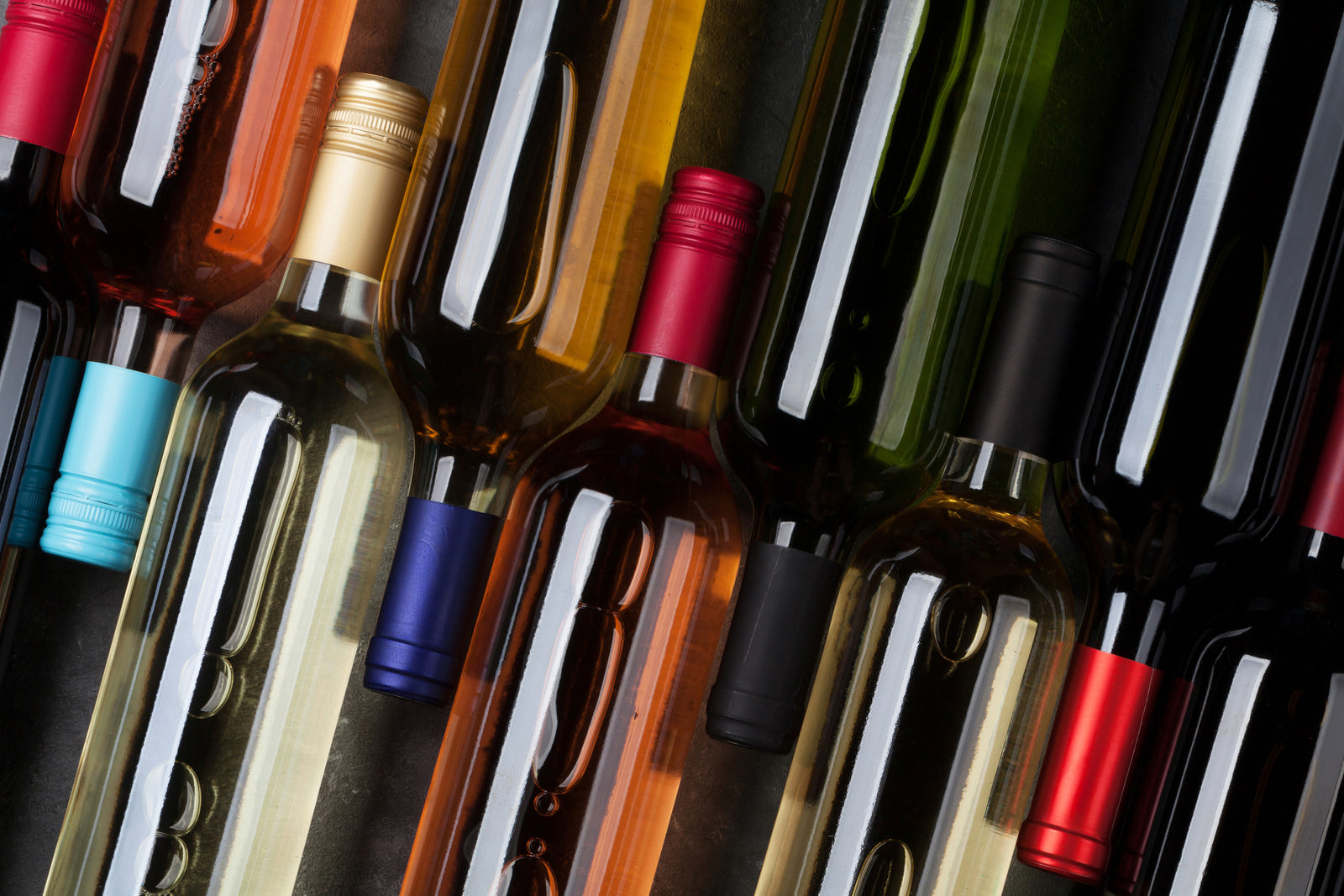Did you know the wine bottle size is more than just for variation and serving options? According to a study, wine bottle sizes and shapes can impact their taste.
They significantly affect the rate at which wine ages, the ease of pouring, and the overall aesthetic appeal. Discover the world of wine bottle sizes and how they impact your wine-tasting experience in our comprehensive guide, specially made for wine lovers.
Understanding Wine Bottles Sizes

Wine bottles come in various sizes, each with its unique name and capacity. Whether hosting an intimate dinner party or celebrating a special occasion, understanding the different wine bottle sizes can help you choose the perfect bottle for any event.
What is the size of the wine cork?
The size of the cork you need for your wine bottle depends on the diameter of the bottle's opening. The standard opening of a 750 ml wine bottle is 3/4 of an inch. If you have a wine bottle corker, you will want to purchase the size #8 or #9 corks. The diameter of these corks is 7/8" and 15/16", respectively. Size #9 corks is what the commercial wineries use. Please note that the cork size is determined by the diameter of the bottle's opening, not the height of the bottle.
Wine Bottle Sizes: A Historical Perspective
Wine bottle sizes have evolved throughout history, and their names often have fascinating origins. Let's take a journey back in time and explore the historical significance of wine bottle sizes:
Biblical Kings and Wine Bottle Sizes
In ancient times, wine bottle sizes were often associated with biblical kings. For example, a bottle known as the "Rehoboam" (4.5 L) was named after the king of Judah, who reigned in the 10th century BC. The "Jeroboam" (3 L) refers to the first king of the northern Kingdom of Israel.
Napoleon and Champagne
The term "magnum" originated from the reign of Napoleon Bonaparte. It is said that he favored Champagne and requested bottles that were twice the size of a standard bottle. The word "magnum" means "great" or "large" in Latin. Thus, the magnum size (1.5 L) was born.
Historical Context
Cultural and societal factors have also influenced wine bottle sizes throughout history. For instance, larger format bottles were often used for ceremonial purposes or to signify wealth and opulence.
How Size Impacts Taste

How can the different bottle sizes of wine impact your wine-tasting experience?
Wine-to-Air Ratio
The amount of wine in a bottle relative to the air volume inside can affect the aging process and, ultimately, the taste. Smaller bottles have a higher wine-to-air ratio, resulting in a faster aging process and potentially more pronounced flavors.
Temperature Control
Larger bottles, such as magnums or larger format bottles, have thicker glass and greater volume, which can provide better insulation and temperature control. This stability can help preserve the wine's freshness and prevent temperature fluctuations that may alter the taste.
Optimal Conditions
The larger size of certain bottles, like magnums, can also create a more favorable aging environment. The increased volume allows for slower and more controlled oxygen exposure, promoting a smoother and more harmonious development of flavors over time.
Bottle Sizes for Different Wines
Different wine regions around the world often have their preferences when it comes to bottle sizes and shapes. Let's explore how these variations can reflect the unique characteristics of each region:
Bordeaux Bottles
Bordeaux wines, known for their elegant and structured reds, are typically bottled in a specific style. Bordeaux bottles have high shoulders, straight sides, and a tall shape. This design showcases the wine's label and allows easy stacking and storage.
Burgundy Bottles
In contrast, wines from the Burgundy region are often bottled in a different style. Burgundy bottles have wider and sloping shoulders, which can accommodate the broader and rounder shape of the Burgundian Pinot Noir and Chardonnay grapes. The curvaceous design adds elegance to the bottle.
Champagne Bottles
Champagne, the sparkling wine produced in the Champagne region of France, has a unique bottle shape. The "Champagne bottle" features a thicker glass and a punt (the indentation at the bottom). This design helps withstand the pressure from the carbonation, ensuring the bottle's structural integrity.
Regional Preferences
Beyond Bordeaux, Burgundy, and Champagne, other wine regions may have their own bottle preferences. For instance, German Rieslings are often bottled in tall, slender bottles, while Italian wines, such as Chianti, are commonly found in the classic, round-shouldered bottles.
Standard Wine Bottle: The Gold Standard

The wine bottle's standard design is still the most preferred choice for winemakers and wine lovers. This iconic bottle shape has become the gold standard in the wine industry. Let's get into more details of the standard wine bottle:
1. Capacity: The standard wine bottle typically holds 750 ml (milliliters). This is equivalent to about 25.4 fluid ounces or roughly 5 glasses of wine (based on a typical 5-ounce serving size).2. Punt: Have you ever noticed the deep indentation at the bottom of a wine bottle? That's called the punt. Initially, the punt was used to strengthen the bottle and provide stability. The purpose of the punt has been the subject of much speculation. There are several theories but no clear consensus. Here are some of the most plausible explanations:
- Easier to hold: The punt provides a spot to place your thumb while the rest of your fingers grab the base of the bottle, making it easier to hold.
- Stability: The punt provides stability to the bottle, preventing it from tipping over and potentially shattering.
- Sediment collection: The angle of the punt lets sediment collect in a tight area near the base, stopping the sediment from blending back into the wine as it’s being poured.
- Optical illusion: The punt creates an optical illusion that the wine bottle is bigger than it is.
- Marketing: The punt can be used as a marketing tool. A unique bottle shape can make it stand out on a store shelf and draw attention to the brand.
Magnum Bottles for Special Occasions

Consider reaching for a magnum bottle or larger format when raising a glass in celebration. Here's why these larger sizes are preferred for those memorable moments:
- Impressive Presentation: Magnum bottles create a visual impact and make a statement with their larger size. Placing a magnum on the table immediately signals that something special is being celebrated and adds an air of grandeur to the occasion.
- Extended Aging Potential: The larger volume of a magnum bottle benefits the wine's aging process. With more liquid in the bottle, the wine ages more slowly, allowing for a longer and more gradual development of flavors. This can result in a more complex and harmonious tasting experience.
- Shared Experience: Sharing a magnum bottle with friends and loved ones fosters a sense of camaraderie and togetherness.
- Efficiency and Convenience: Serving wine from a magnum or larger bottle can be more efficient, especially when hosting a larger gathering. It reduces the need for frequent bottle changes and ensures everyone's glasses remain consistently filled throughout the evening.
Unconventional Bottle Sizes and Shapes
The wine industry's unconventional bottle sizes and shapes add a touch of novelty and excitement, making for interesting conversations. Aside from the split, magnum, and larger sizes, some wineries have started experimenting with square-shaped bottles. Deviating from the traditional round shape, these unique bottles provide a distinctive aesthetic appeal and offer practical advantages, such as efficient storage and reduced risk of rolling.
Bottle Size and Wine Types
The size of a wine bottle can impact different types of wine, influencing factors such as aging, temperature, and the overall drinking experience. Let's explore how bottle size can affect specific wine types:
White Wines
White wines, known for their delicate flavors and aromas, can benefit from smaller bottle sizes. With a lower wine-to-air ratio, smaller bottles can help preserve white wines' freshness and vibrant characteristics. This is particularly important for light and crisp varietals such as Sauvignon Blanc and Pinot Grigio.
Red Wines
Red wines often benefit from larger dimensions. The increased volume in larger red wine bottle sizes, such as magnums, allows for a more gradual aging process. This can result in a smoother integration of tannins and a more complex flavor profile. Full-bodied reds like Cabernet Sauvignon and Syrah can showcase their true potential when aged in larger format bottles.
Sparkling Wines
Champagne and sparkling wines are usually bottled in thicker glass bottles with a punt at the bottom. This design helps maintain the pressure from the carbonation and preserves the effervescence.
The Role of Bottle Size in Wine Collecting
For wine collectors and enthusiasts, bottle size plays a significant role in wine collecting and cellaring. Here are the roles of bottle size in wine collecting:
- Aging Potential: Larger bottles, like magnums or bigger, can age wine more gracefully due to slower maturation.
- Market Value: Certain bottle sizes, especially rare or unique formats like Nebuchadnezzars or Melchiors, can hold higher market value and are sought after by collectors.
- Rare Editions: Some limited editions or special releases are exclusively available in specific bottle sizes, making them highly coveted for collection.
- Social Occasions: Different bottle sizes cater to various social settings, with smaller ones like splits being perfect for solo enjoyment while larger formats are ideal for celebrations and gatherings.
- Storage Efficiency: Larger bottles, although bulky, can be more space-efficient for long-term storage, reducing the number of bottles needed to store the same volume of wine.
- Aesthetic Appeal: Collectors often appreciate the visual impact of diverse bottle sizes in a collection, adding variety and uniqueness to their displays.
Takeaway

In the world of wine, the size of the bottle might seem like a trivial detail, but it can have a profound impact on the flavor and overall drinking experience. Understanding wine bottle sizes and their effects on taste allows you to make informed choices and enhance your appreciation of this ancient libation. Each bottle has its story, from the standard wine bottle to the unconventional and eye-catching shapes and sizes. What story does your wine collection tell?
Do you collect wines in different sizes and shapes? Share your experience in the comment below! We'd love to hear from you.


